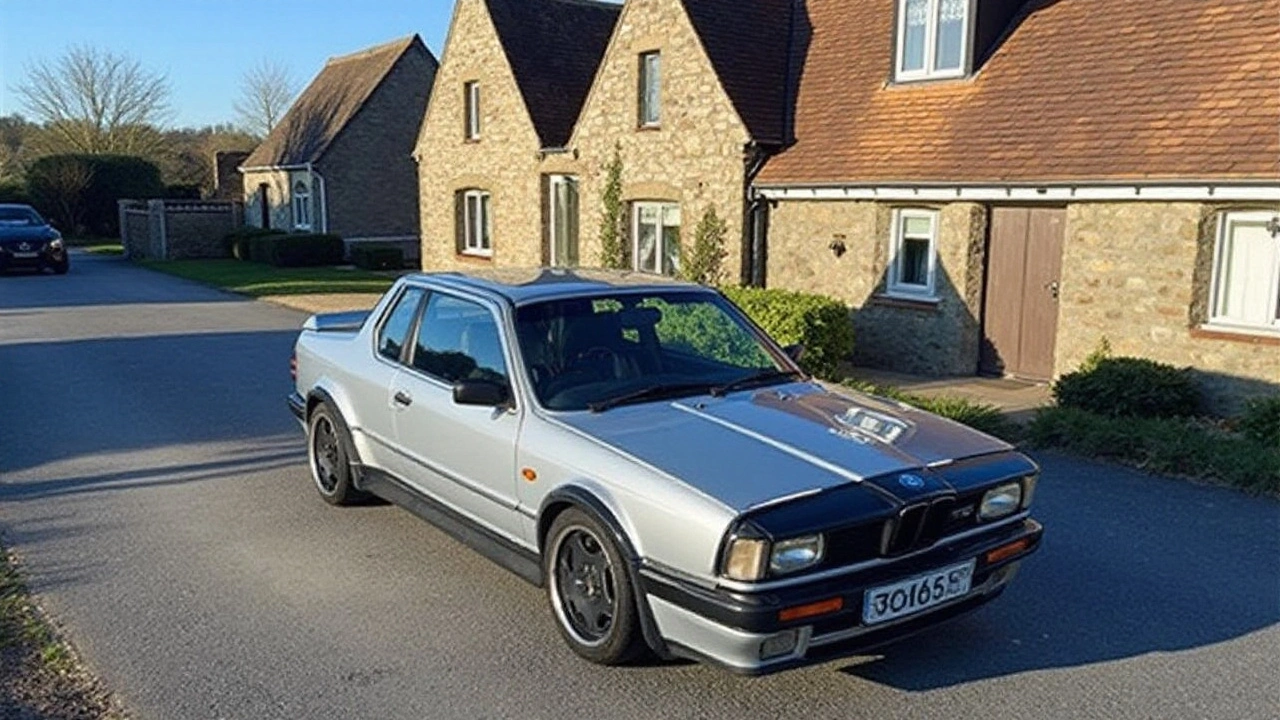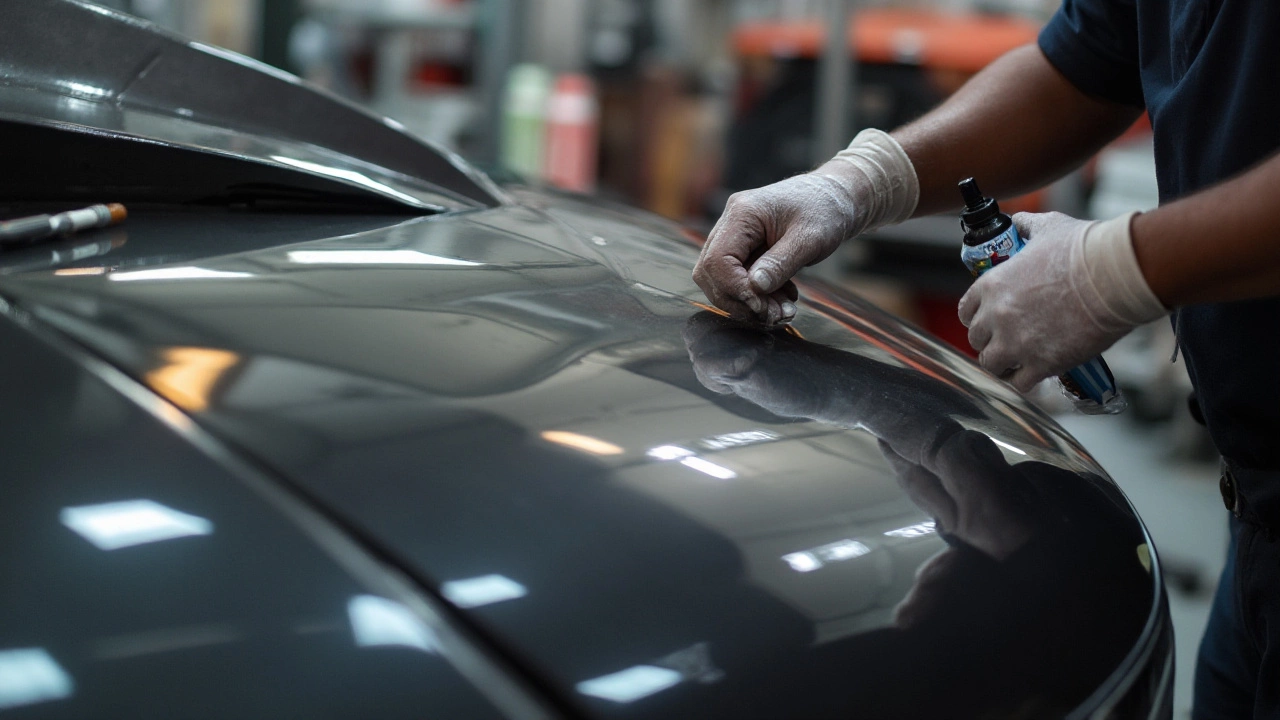The carbon fiber spoiler has become an integral part of modern car aesthetics, adding not just performance attributes but a visually striking appeal. However, the elements can gradually take their toll, leaving the once-lustrous surface looking faded and worn. Fear not, for giving your spoiler a facelift doesn't have to be a daunting task.
In this guide, you'll find a straightforward approach to rejuvenating your carbon fiber spoiler, uncovering the tricks of the trade that professionals rely on. From understanding why fading occurs to the essential items you'll need on hand, each step is designed with the car enthusiast in mind. Whether you're preparing for a car show or just want your ride to turn heads once again, these methods will help you achieve a showroom-worthy finish with confidence.
- Understanding Carbon Fiber Spoilers
- Common Causes of Fading
- Necessary Tools and Materials
- Step-by-Step Restoration Process
- Applying Finishing Products
- Maintaining Your Spoiler's Look
Understanding Carbon Fiber Spoilers
Carbon fiber spoilers have gained a celebrated status in the automotive world, thanks to their unique blend of functionality and style. Made from a polymer reinforced with fibers of carbon, these spoilers are renowned for their exceptional strength-to-weight ratio, making them a preferred choice for both racing enthusiasts and car aficionados. The material's history can be traced back to high-stakes industries like aerospace, where its durability and lightweight properties were initially recognized. Today, this advanced material is widely employed in various automotive components, imparting not just a visual flair but also significant aerodynamic benefits to vehicles.
The integration of a carbon fiber spoiler is not only a statement of interest in high-performance design but also contributes to reducing aerodynamic drag. This efficiency can enhance the handling and speed of the vehicle, providing drivers with an edge in both everyday and competitive driving scenarios. However, what really sets carbon fiber apart is its ability to be molded into complex patterns and designs without compromising on weight. This opens up endless possibilities for customization, allowing car owners to personalize the look of their vehicles. Such flexibility is part of the allure that keeps carbon fiber in high demand across the automotive industry.
Despite its advantages, even the mightiest carbon fiber can fall victim to environmental factors. Exposure to sun, rain, and pollutants can dull its striking finish. To maintain its aesthetic allure, proper care and maintenance routines are vital. A faded spoiler not only detracts from the car's appearance but can also affect potential resale value. Regular upkeep can extend the lifespan of the spoiler, preserving both its functionality and shine. Carbon fiber parts demand a touch of precision in maintenance, rewarding those who invest the time to care for them with continued performance and visual appeal.
There's an artist's touch in the creation of carbon fiber, as each weave and layer is methodically planned and executed. This process results in a pattern that is as strong as it is beautiful, a testament to advanced engineering meeting aesthetic grace. The intricate design of the fabric weave, visible through many coatings, gives the material its signature look. It is this visual appeal that often drives enthusiasts to opt for a carbon fiber spoiler, despite its higher cost compared to other materials. In a world that celebrates individuality and performance, carbon fiber remains a top-tier choice, embodying both.
"Carbon fiber remains unparalleled in strength and beauty, turning ordinary vehicles into extraordinary works of art," said renowned automotive designer, James Peterson.The journey of carbon fiber from technology pioneers to the forefront of automotive design has been remarkable. This evolution is part of what makes caring for and maintaining your carbon fiber components so important. When one understands the legacy and innovation that goes into each piece, it becomes clear why restoration and maintenance efforts are just as significant in preserving the art and science imbued in every fiber.
Common Causes of Fading
The allure of a carbon fiber spoiler is undeniable, gracing each car with both style and aerodynamic benefits. Yet, no matter its initial brilliance, time and elements can conspire to dim its luster. Understanding the agents behind this transformation is the first step in reversing its effects. Environmental factors rank high among the culprits. Take sunlight, for instance. Prolonged exposure to UV rays doesn’t just bronze skin; it also leads to the degradation of the resin that holds the carbon weave intact, causing a bleached appearance over time. Regular exposure to such intense sunlight gradually breaks down the outer layers of your spoiler, leaving it looking aged and pale.
Another silent assailant is moisture. Rain, dew, and even the moisture in morning fog can seep into the minute pores of the spoiler’s surface, especially if the protective coating is compromised. This moisture, teamed with pollutants and acidic components in the water, can instigate a microscale level corrosion that dulls the material. It’s a slow, insidious process that transforms a glossy surface to a matte finish over months and years.
In urban settings, pollution levels cannot be ignored. The air carries abrasive particles that settle as a grimy layer on surfaces. For car detailing enthusiasts or car owners who frequent bustling cityscapes, the roughness these particles introduce can lead to a similar abrasive fading effect that sandpaper would impart. This additional wear and tear compounds with other environmental challenges, propelling the fading process.
The choice of cleaning products plays a significant role, too. Many everyday cleaners contain harsh chemicals that, while effective at removing grime, can inadvertently strip away the protective coatings of the spoiler. It's tempting to grab a multi-purpose cleaner, but these products aren't always formulated with carbon fiber in mind. Over time, repeated cleaning with these products eats away at the finish, exacerbating fading.
"Ignoring the environmental impact on your vehicle can be detrimental. Regular maintenance uses the elements to your advantage rather than letting them erode your investment," notes renowned automotive expert James Pollock.
Other contributors include abrasion from washing methods that are too aggressive, and bird droppings, which are acidic enough to damage your paint and spoil over time. Neglecting these factors or lacking knowledge about their implications can speed up the unwanted fading of the spoiler. Recognizing these causes empowers car lovers to take informed action to protect and maintain that coveted polished look.

Necessary Tools and Materials
Restoring a carbon fiber spoiler to its original condition requires having the proper tools and materials at your disposal. Before starting the process, gather all the necessary supplies to ensure a smooth and efficient restoration. The first essential item is a mild dish soap or automotive specific cleaner, which will help in removing surface dirt and grime. These cleaners break down contaminants without damaging the fine weave of carbon fiber. Next, secure a supply of microfiber cloths. These are crucial for both applying the cleaning products and drying the spoiler without leaving scratches or lint, preserving its smooth, sleek surface.
After cleaning, your focus should turn toward addressing any fading. To do this, obtain a top-quality polishing compound specifically designed for carbon fiber materials. This type of compound helps in revitalizing the depth and gloss of the spoiler. Coupled with a dual-action polisher, the compound can significantly restore the color and shine of the faded spoiler, making it appear almost new. For those working without a machine, a soft foam applicator pad will work sufficiently, albeit with more elbow grease required. Keep in mind the importance of polishing under controlled conditions, as the compound reacts differently to heat and pressure.
Sealing in the restored look of your spoiler is the final critical step, necessitating the use of a protective wax or ceramic coating. These products not only enhance the polished finish but also serve as a shield against UV damage, a major cause of fading. It’s often said that prevention is better than cure, and coating your spoiler in a protective layer ensures lasting beauty. For meticulous detailers, consider applying a UV-protective spray regularly after waxing, as this adds additional protection against the sun’s harsh rays. As the automotive enthusiast Henry Barden once noted,
“A little effort in maintaining your car's surface goes a long way in preserving its glory.”
Of course, safety should be paramount during the restoration process. Don’t skip on protective gear such as gloves and safety goggles, particularly when handling chemicals and polishing compounds. Make sure your workspace is well-ventilated to disperse any fumes effectively. Finally, a soft, clean tarp or drop cloth is a wise investment to protect the surrounding areas from polishing residue. With these items at hand, you are well-equipped to embark on restoring your carbon fiber spoiler to its former grandeur, ensuring it complements your vehicle’s look with a pristine finish.
Step-by-Step Restoration Process
Reviving your carbon fiber spoiler involves a methodical approach to restore its gleam and bring back that fresh-from-the-factory look. The process is precise yet rewarding, demanding some patience and attention to detail. Begin by gathering the right materials: high-quality detergent for cleaning, microfiber towels, sandpaper ranging from 800 to 2000 grit for smoothing, and polishing compound. An essential aspect is selecting the appropriate protective sealant to guard against future damage.
The first task is dislodging grime and built-up debris. Use a pH-balanced detergent mixed with water to scrub the spoiler gently but thoroughly. It's crucial to use a microfiber towel at this stage to avoid introducing new scratches. This initial step might seem minor, but cleansing the surface is a pivotal factor in achieving a smooth end result. As you clean, inspect the surface for chips and cracks, as these imperfections will need attention later in the process.
Sanding the Surface
Once your spoiler is spotless, it's time to move on to sanding, which is vital in dealing with oxidation and deeper fading. Starting with 800-grit sandpaper, you begin eliminating the top layer of oxidized material. This can initially obscure the surface, but don’t worry—this is part of the transformation. Incrementally increase the grit level to refine the surface, advancing to 1000, 1500, and finishing with 2000-grit paper. Each step smooths out the prior marks, decreasing in coarseness, and bringing you closer to that polished state.
“The act of sanding is not about removing material; it’s about revealing the flawless surface beneath,” - Auto Detailing Expert, John Simons.
Taking your time with sanding pays off in the form of a perfectly smooth finish. Remember, even pressure is key, and laden the sandpaper with just enough water to lubricate as you proceed. Don't rush this process, as it sets the foundation for all polishing to follow
Polishing and Finishing
With a finely sanded surface, the next phase involves polishing. Use a robust polishing compound to bring out the lost shine, applying it with a soft cloth or a dedicated polishing tool for larger areas. Circular motions help diffuse the compound evenly, preventing excessive accumulation. As the compound works its magic, wipe off the residue and reveal the shimmering shine beneath. The contrast from the earlier faded hue is often astonishing at this stage.
The final step is applying a protective coat once the polish has set in. Choosing a high-quality automotive sealant provides a barrier against UV rays and environmental pollutants, crucial for sustaining the restored look of your spoiler. A carbon fiber spoiler benefits immensely from a periodic layer of wax or sealant influenced by your driving environment and exposure conditions.
Protection won't just cosmetically appeal; it's an investment in the longevity of the spoiler’s new finish. Armed with these strategic steps, you not only enhance your vehicle’s appearance but ensure it remains impressive for years to come.

Applying Finishing Products
Once you've lovingly cleaned and prepped your carbon fiber spoiler, the next pivotal step is applying the right finishing products to protect and enhance its **carbon fiber** allure. These products serve not only to revive the appearance of your spoiler but also to safeguard it against future environmental damage. Ensuring you use the correct items and techniques is vital for success.
Among the myriad of options available, a high-quality clear coat is indispensable. It's like giving your spoiler a new skin, rejuvenating its luster while forming a barrier against UV rays and road debris. Start by selecting a clear coat designed for **carbon fiber** to prevent discoloration. Sand the surface very lightly with fine-grit sandpaper to provide a good mechanical bond for the finish. Wipe it clean again to ensure no residues remain.
Consider, for example, the advice of auto detailing experts: “Investing in ceramic coatings can create a stunning gloss that provides robust protection,” says a detailing specialist.
"Ceramic coatings form a semi-permanent bond with the paint, adding another layer that the eye perceives as more depth and shine," explains the detailing guru from Detailing World.While clear coats are a trusted choice, exploring ceramic coatings can offer enhanced durability, often lasting several years with proper maintenance.
Applying these products usually involves multiple steps and a bit of patience. Begin by masking off surrounding areas to avoid overspray. Hold your spray can or gun about six to ten inches from the surface, moving in steady, overlapping passes to ensure even coverage. Multiple thin coats are often better than one thick coat, reducing chances of runs and drips. Allow each layer to dry according to product guidelines before applying the next.
Post-application Buffing
After applying the final coat, bring out the spoiler's shine through meticulous buffing. This not only enhances the gloss but also smooths out any minute imperfections. Use a dual-action polisher with a soft foam pad for best results. Carefully work the surface in small sections, applying gentle pressure to achieve a uniform polish. Finish by waxing your spoiler, which acts as an additional clear barrier, keeping dirt, water, and UV rays at bay.In a small study conducted by car enthusiasts, it was found that spoilers treated with both a clear coat and a wax had a 30% increased resistance to fading over a five-year period compared to those left untreated.
Maintaining Your Spoiler's Look
Once you've painstakingly restored the shine of your carbon fiber spoiler, keeping it in pristine condition becomes the next crucial step. Regular maintenance is pivotal to ensure your spoiler maintains its brilliance against the trickling effects of time and exposure to the elements. A proactive approach is not only rewarding but essential. Begin by washing your spoiler at least every two weeks using a gentle car wash soap that is specifically formulated to be safe for carbon fiber and coated surfaces. Avoid harsh detergents that can strip away protective coatings, diminishing the vibrant sheen you worked hard to restore.
Protective coatings are your spoiler's best friend, acting as a barrier against the sun's UV rays and environmental pollutants. Applying a high-quality wax or sealant, designed specifically for carbon fiber, adds an extra layer of protection, keeping your finish sleek and durable. Many detailing enthusiasts tout the benefits of ceramic coatings for their longevity and superior protection. “Properly applied ceramic coatings can last several years, offering the ultimate in protection with minimal maintenance,” suggests James White, a respected auto detailing specialist. Ceramic coatings not only protect but also bring out the depth and gloss of the carbon fiber weave, creating an impressive visual impact.
Each season presents its own set of challenges, and being attuned to these can help you adjust your maintenance routine accordingly. During winter, road salts can wreak havoc, so additional cleaning and protective measures become necessary. Conversely, the intense summer sun requires more frequent application of UV protectants to combat fading. Even though carbon fiber is resilient, it is not immune to the effects of prolonged exposure, which underscores the importance of vigilance and routine check-ups.
Temperature fluctuations and humidity can lead to condensation and potentially trap moisture between the spoiler and its clear coat. Keep an eye out for signs of clouding or discoloration, and address these concerns promptly to prevent more severe damage. Regularly inspect your spoiler for chips or scratches, and repair them early to prevent them from growing into more significant issues over time. A stitch in time saves nine, as they say, particularly when it comes to maintaining the structural and aesthetic integrity of carbon fiber components.
It pays to invest in a high-quality car cover if your vehicle spends a significant amount of time outdoors. Not only does this afford a layer of physical protection from debris and bird droppings, but it also shields against excessive UV exposure. For those who drive frequently in varied climates, consider parking in shaded areas whenever possible. This simple step can dramatically prolong the lifespan of your efforts, ensuring your carbon fiber spoiler remains a point of pride for years to come.
Finally, consider documenting the condition of your spoiler through photographs each season. This serves as an excellent reference to gauge its status over time and can indicate when restoration efforts might become necessary once more. Avoid complacency, as consistent care is the simplest path to maintaining your spoiler's impact and allure. With thoughtful maintenance, your carbon fiber spoiler can continue to add that iconic edge to your vehicle's character.




